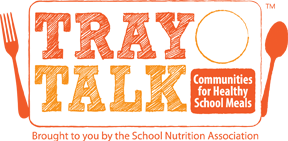 The School Nutrition Association (SNA) launched a PR campaign called Tray Talk in 2010. The official website (www.TrayTalk.org), is designed to emphasize the benefits of school meals and showcase success stories from school nutrition programs nationwide. SNA members can help send positive messages about school meals by submitting their own “school nutrition success stories” at the Tray Talk website.
The School Nutrition Association (SNA) launched a PR campaign called Tray Talk in 2010. The official website (www.TrayTalk.org), is designed to emphasize the benefits of school meals and showcase success stories from school nutrition programs nationwide. SNA members can help send positive messages about school meals by submitting their own “school nutrition success stories” at the Tray Talk website.
Here is some of the information shared on the site:
School meals are well-balanced, healthy meals that are required to meet science-based, federal nutrition standards.
-
- No more than 30% of calories can come from fat, less than 10% from saturated fat
- Meals must provide 1/3 of Recommended Dietary Allowances of protein, vitamins A and C, iron and calcium
- School meals are served in age-appropriate portion sizes
- Every School Lunch Includes five choices that add up to a great value:
- Milk – Fat free or 1% – flavored or regular
- Vegetables – From jicama slaw to fresh carrot sticks
- Fruit – Everything from kiwi to locally grown apples; often fresh
- Grains – More whole grain items like rolls or sandwich bread
- Meat or meat alternate –White meat chicken, bean chili, lean beef
-
In January 2011, the US Department of Agriculture released proposed nutrition standards including new calorie and sodium limits, larger fruit and vegetable serving sizes and requirements to expand the variety of vegetables served in schools each week. The standards were finalized in 2012.
The School Nutrition Association makes the case for your child eating a school lunch saying, “A school lunch provides students with their choice of milk, fruits and vegetables, grains and proteins. School meals are a great value and a huge convenience for busy parents. School cafeterias offer students a variety of healthy choices and help children learn how to assemble a well-balanced meal. Parents can be assured that there’s no super-sizing in school cafeterias because federal regulations require schools to serve age-appropriate portions.”
For more information on healthy school meals, visit www.schoolnutrition.org.


